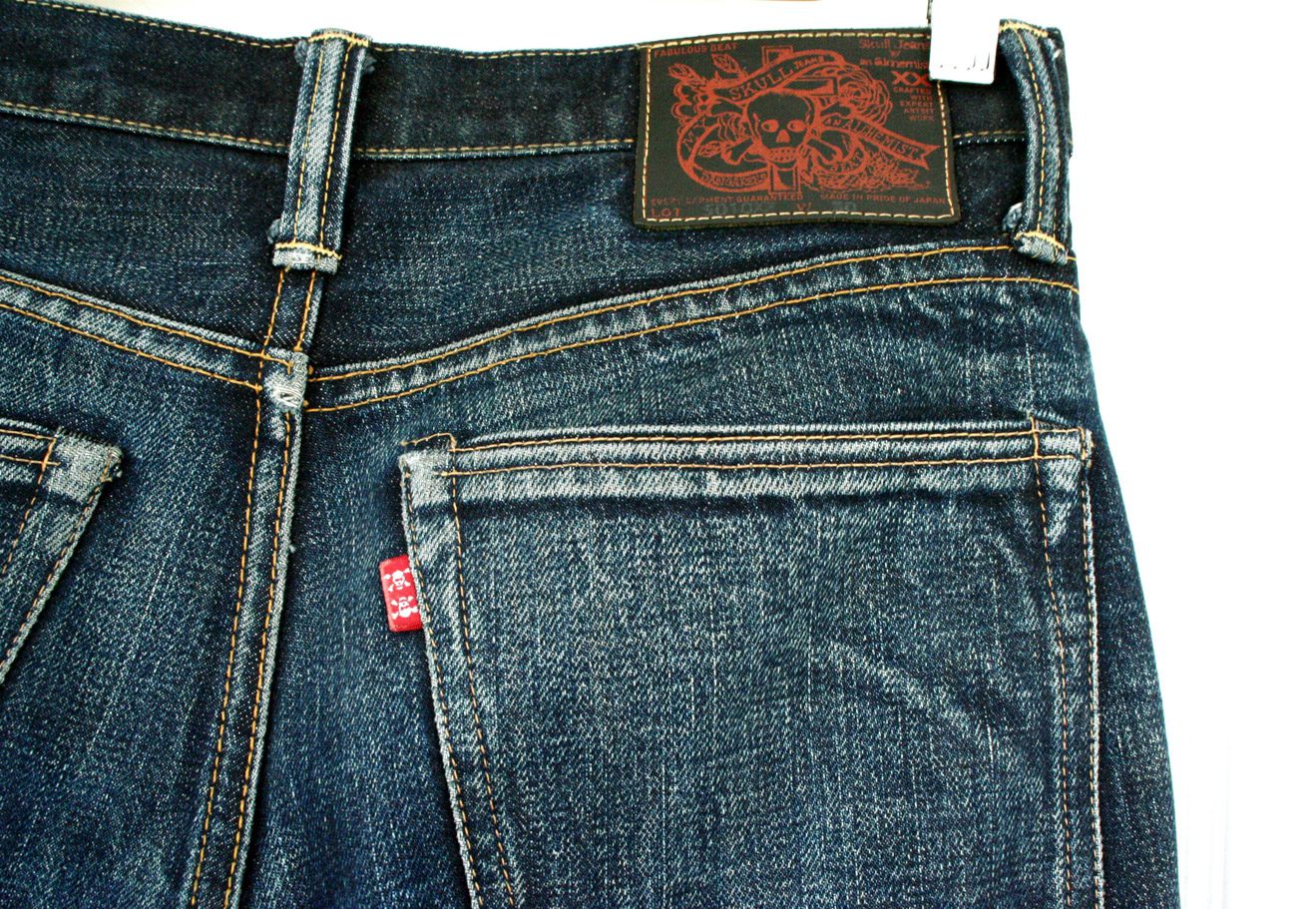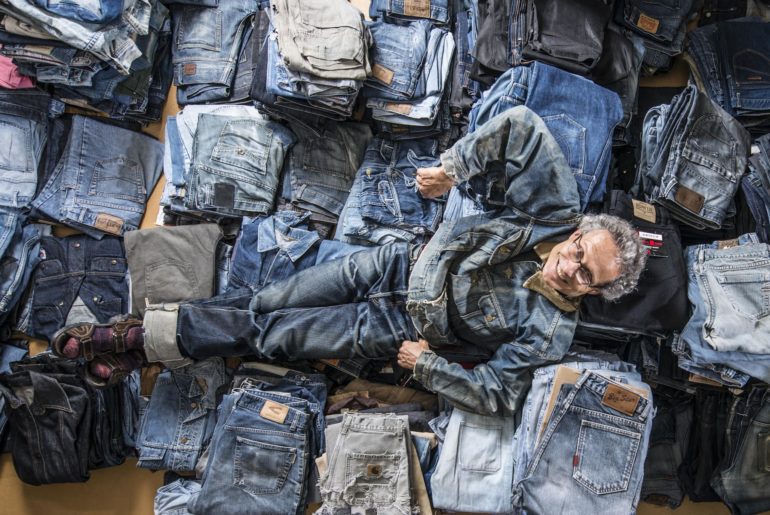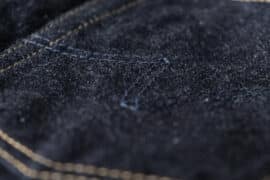Jeans Museum Exhibition at Bluezone Links Denim’s Heritage With Its Future
This blog post is sponsored by Bluezone, the independent show for denim and sportswear by Munich Fabric Start. Register for the next show here!
Denimheads are like the patriots of the world of denim.
We favour denim’s past. We like to create our own fades on jeans made from shuttle-loomed denim without any stretch (God forbid!).
And although we know that denim and jeans are ever-evolving, we’ll be like ‘get off my lawn!’ to almost any innovation that changes the original formula.
On the other side, we have the futurists. Designers and makers with visionary ideas for the evolution of jeans and denim. I’m talking about the innovators that brought us stretch denim and jeans with off-the-shelf fades.
But without the past, there wouldn’t be anything to evolve from.
So, when Ruedi Karrer from the Jeans Museum in Zurich and I were tasked with showcasing a few select garments from his vast collection of heavily faded jeans at Bluezone, I used that observation to conceptualise the exhibition:
Eight original details and characteristics of denim and jeans that have inspired innovation. Let’s take a look at each of them.

#1: Domestic Washing ➡️ Industrial Laundering
Until the 1960s, any new pair of jeans you bought was stiff and unwashed. It’s hard to imagine in today’s world where stores that only sell unwashed denim are part of a niche market. Back then, it was the norm.
So what happened? Two things. First, the Americans began exporting already worn and washed secondhand jeans to Europe and Asian in the wake of WWII.
Then, in the mid-60s, when the first new blue jeans became available in Europe and Japan, consumer demand for softer denim garments inspired retailers and brands to begin washing jeans before they sold them.
This gave birth to a whole new branch of the denim industry as well as technologies like stonewashing, bleaching, and more recently enzyme treatments.
If you want to know more about pre-washing, this in-depth post discusses the different methods, while another post looks at the history of pre-washing.

#2: Natural Fades ➡️ Pre-Distressing
Everyone’s all-time favourite thing about denim is the fact that it fades. But not everyone has the patience to wear their jeans for months or even years to get the worn-in look. That’s where pre-distressing enters the picture.
Inspired by fades ‘au naturel,’ denim innovators began recreating the worn-in look with whiskers and honeycombs back in the 1980s using sandpaper and brushes. The pre-distressing tool of the future, though, is the laser.

#3: Rivets ➡️ Reinforcement
Blue jeans equal durability. And the most important original details of blue jeans that makes them durable is the rivet. In my opinion, it’s the single most defining feature of the garment.
It all started with riveted workwear, and rivets have remained a natural part of our jeans. To this day, most jeans have rivets. If they don’t, they surely have bartacks.
For more about rivets and other defining features of jeans that make them durable, check out this post. I’ve also published a short video recently about why jeans have rivets, which you can watch here.
#4: Thread That Breaks ➡️ Poly/Cotton Thread
Most denimheads like original details on their jeans. They’re nostalgic, and not always that practical. One of the details that many jeans makers have updated is the thread that holds their jeans together.
Cotton and linen thread may be the original way, but it’s just not that functional, because it usually breaks rather quickly. Instead, core-spun thread made from a polyester core that’s been wrapped with cotton has become the preferred option for most makers.
#5: Greasy Jeans ➡️ Coatings
If you’ve ever worn a pair of unwashed jeans for a looooong time without washing them, you might have experienced how the denim gets a slight sheen.
What you’re seeing is built-up dirt and grease that is a basically applying a coating to the fabric. Doesn’t sound particularly tasteful, but it does look cool.
And it’s this naturally occurring characteristic of worn and unwashed jeans that’s inspired coated denim.

#6: Tighter Fits ➡️ Stretch Denim
Blue jeans were originally meant to be worn as workwear by men who did physically demanding jobs. They wore jeans with plenty of room to move about in. Things changed when jeans started transitioning into the world of fashion.
As fits got tighter and tighter, wearers experienced the limitations of 100% cotton denim. If you’ve ever tried on a pair of rigid slim-fitting jeans, you know what I’m talking about.
To solve this problem, visionary denim designers and makers began experimenting with adding stretch to the denim. And as stretch denim got better and better, especially within the past 10 years, jeans have gotten even tighter.
To read more about how stretch denim is made, have a look at this post about the spinning stage of the process.

#7: The Red Tab ➡️ Diversity in Branded Details
Probably the most recognisable design feature of blue jeans is the little red tab you find on the back pockets of Levi’s jeans. It was introduced in 1936—a time when all blue jeans had arcuates on the back pockets—as a way for customers to easily recognise the original.
Levi’s trademarked the red tab, which meant competitors ever since have had to come up with other branded details to make their jeans stand out.
You can dive further into the branded details of jeans in this in-depth post.

#8: Arcuates ➡️ Back Pocket Signatures
Another key design feature of blue jeans that has inspired creativity is the decorative stitchings on the back pockets.
Historians argue that jeans have had arcuates since before the first Levi’s jeans. And until Levi’s trademarked their arcuates in 1943, back pockets from any brand looked more or less the same.
With the trademark, competitors were legally forced to change their designs, which have become visual signatures for denim brands.
On the Hunt For Raw Selvedge Jeans?
Launched in 2011 by Thomas Stege Bojer as one of the first denim blogs, Denimhunters has become a trusted source of denim knowledge and buying guidance for readers around the world.
Our buying guides help you build a timeless and adaptable wardrobe of carefully crafted items that are made to last. Start your hunt here!







